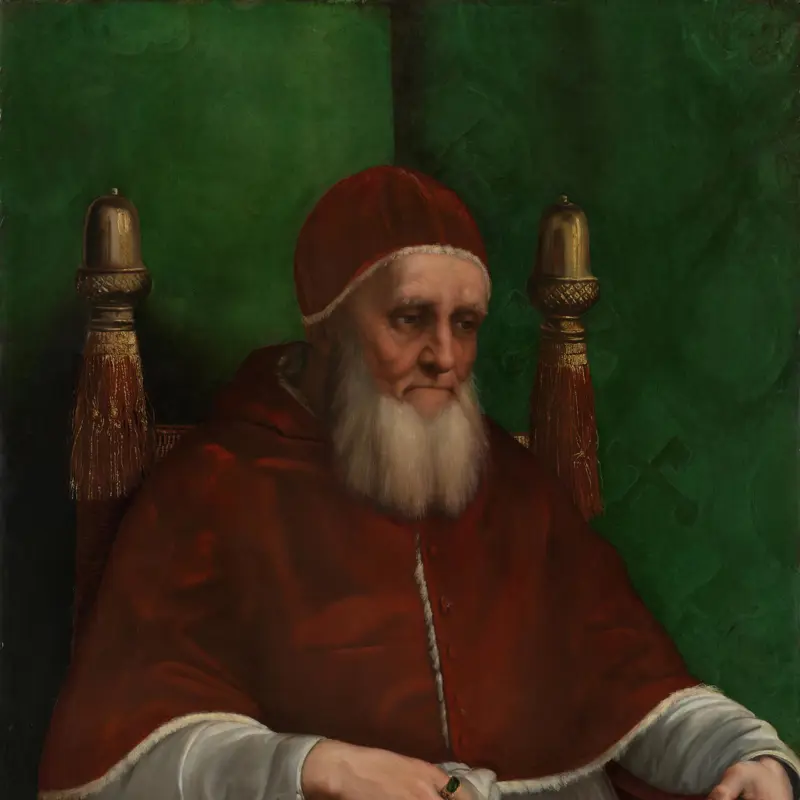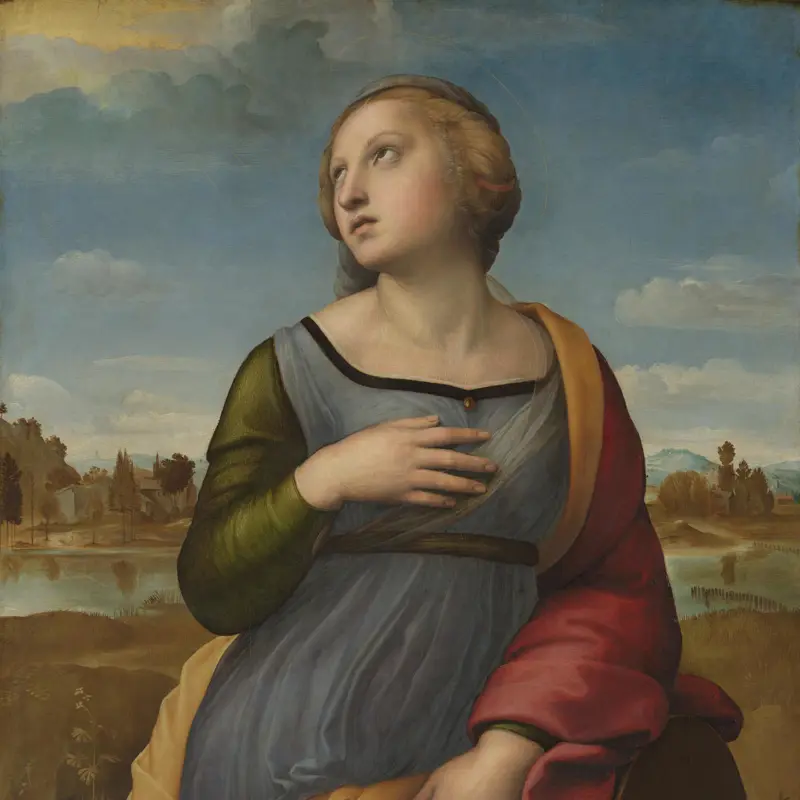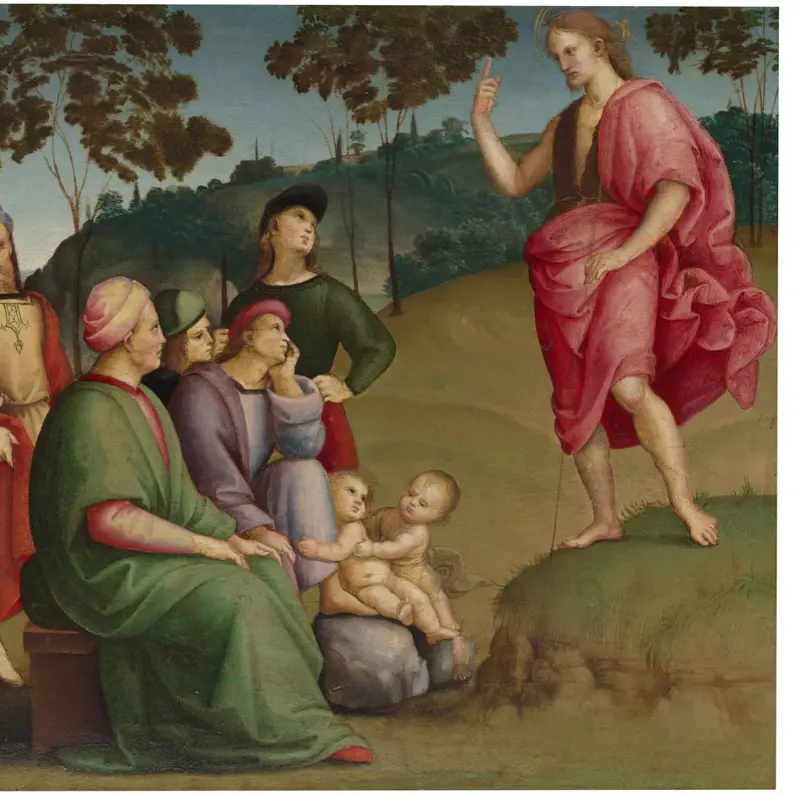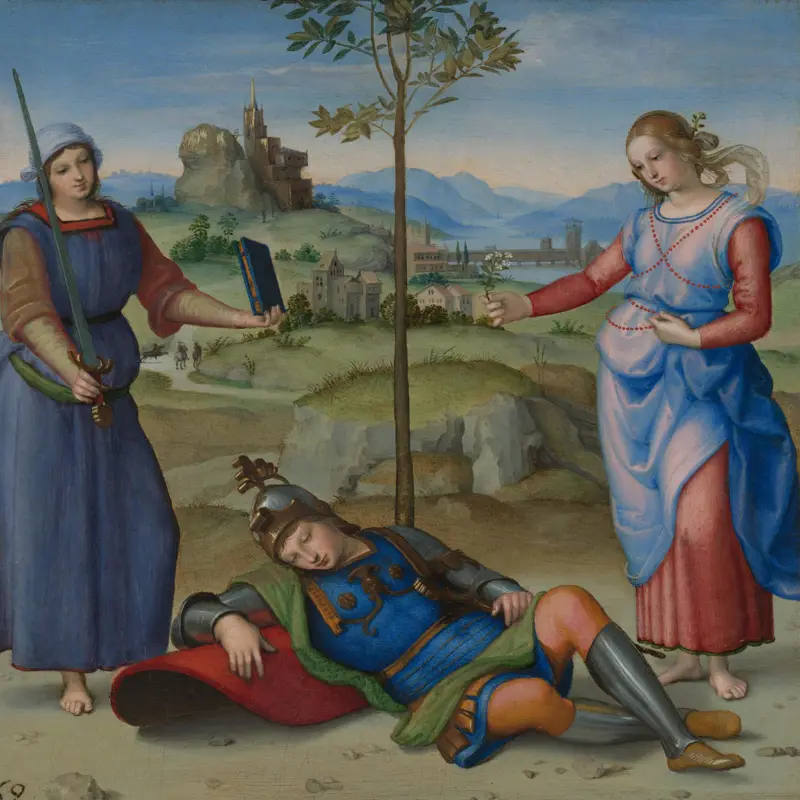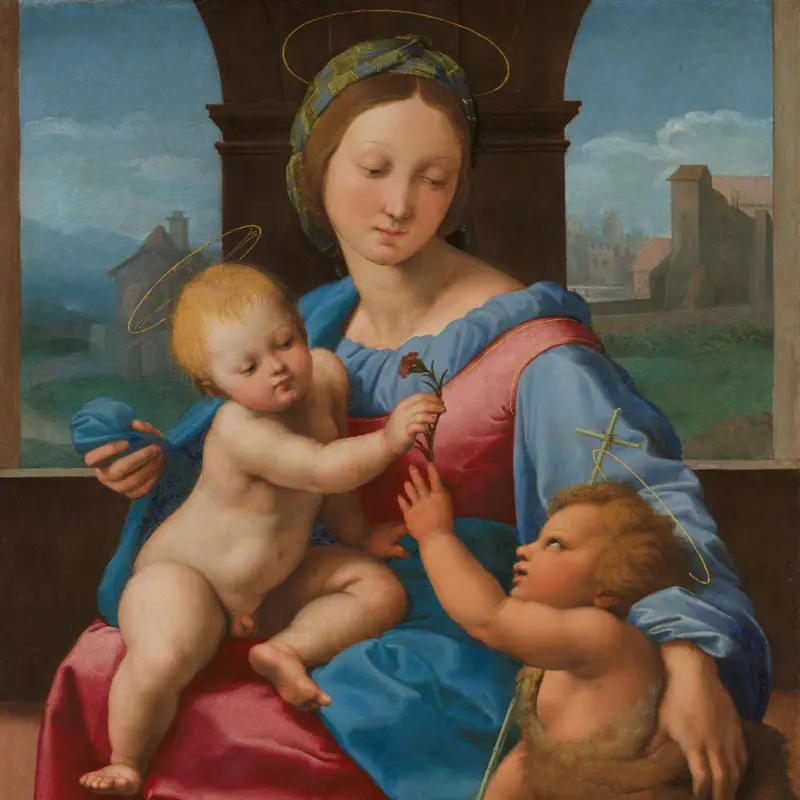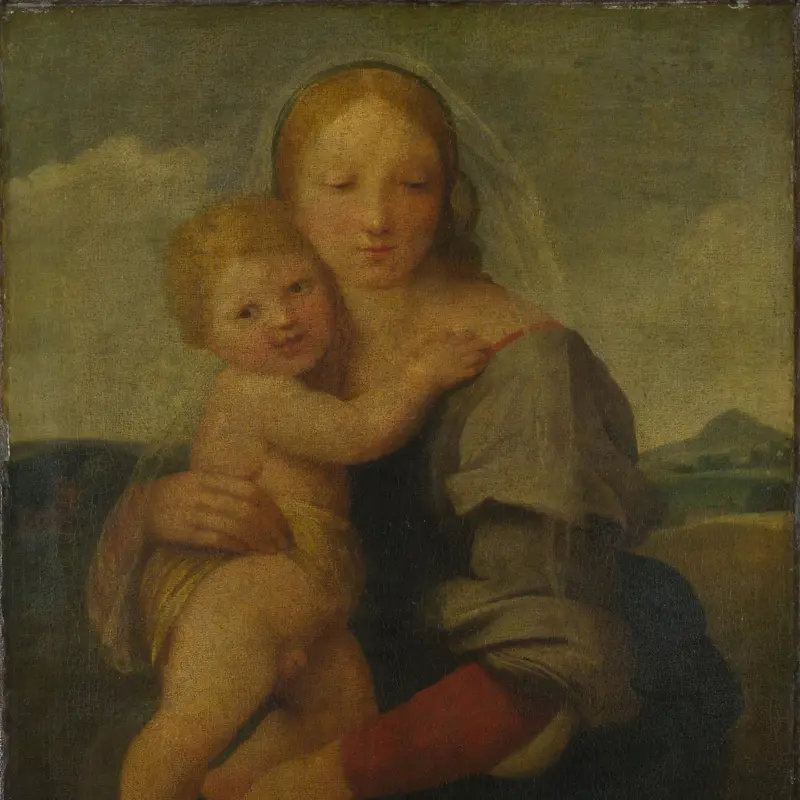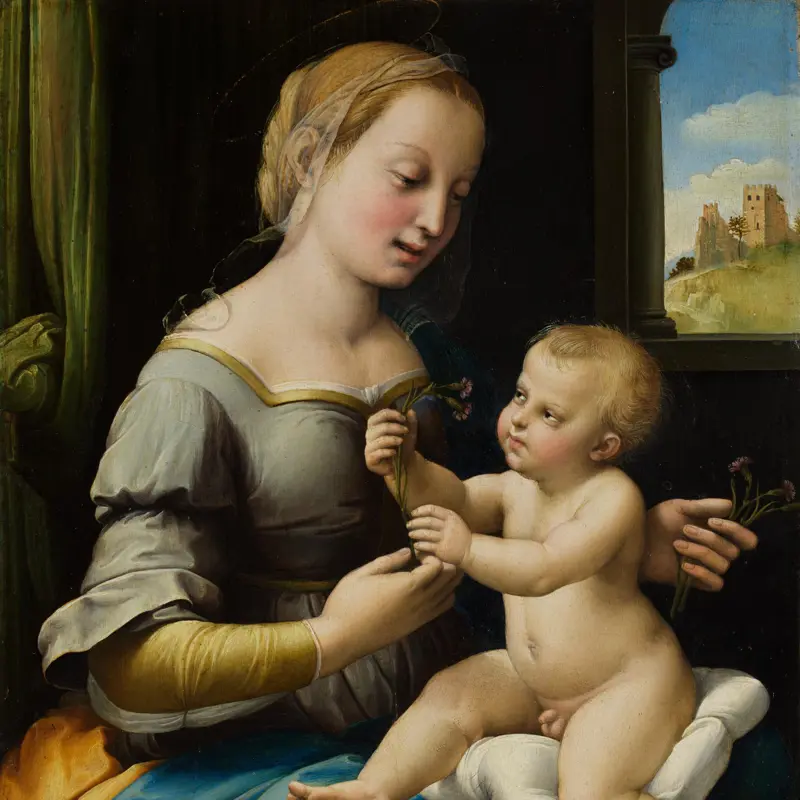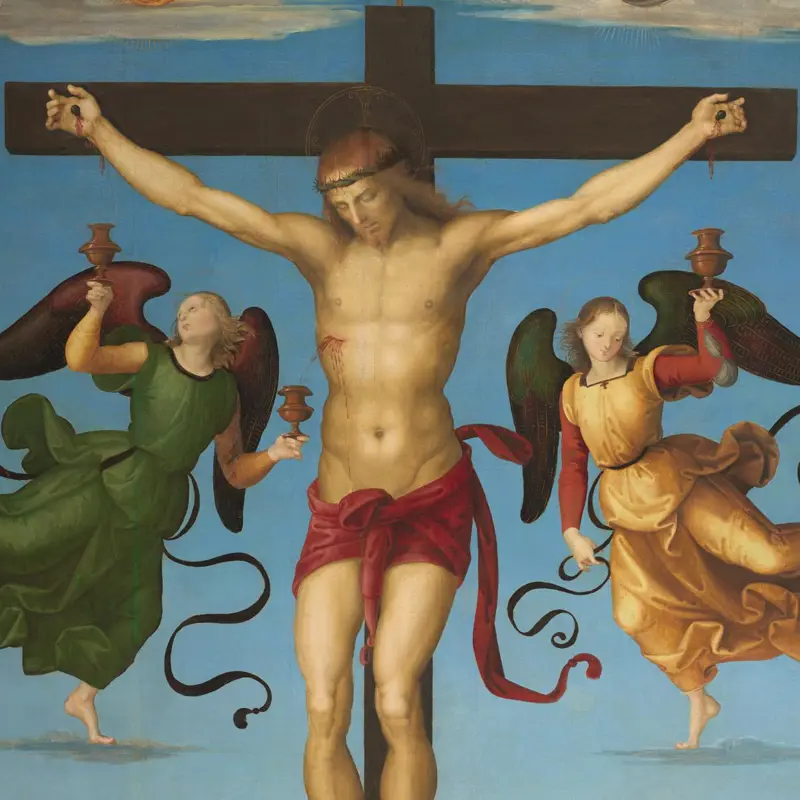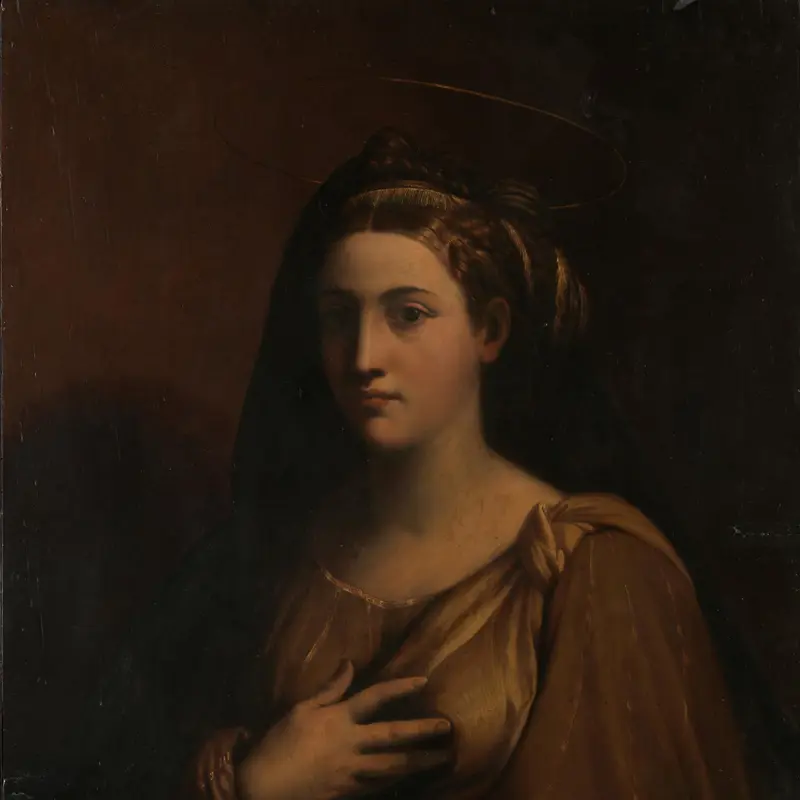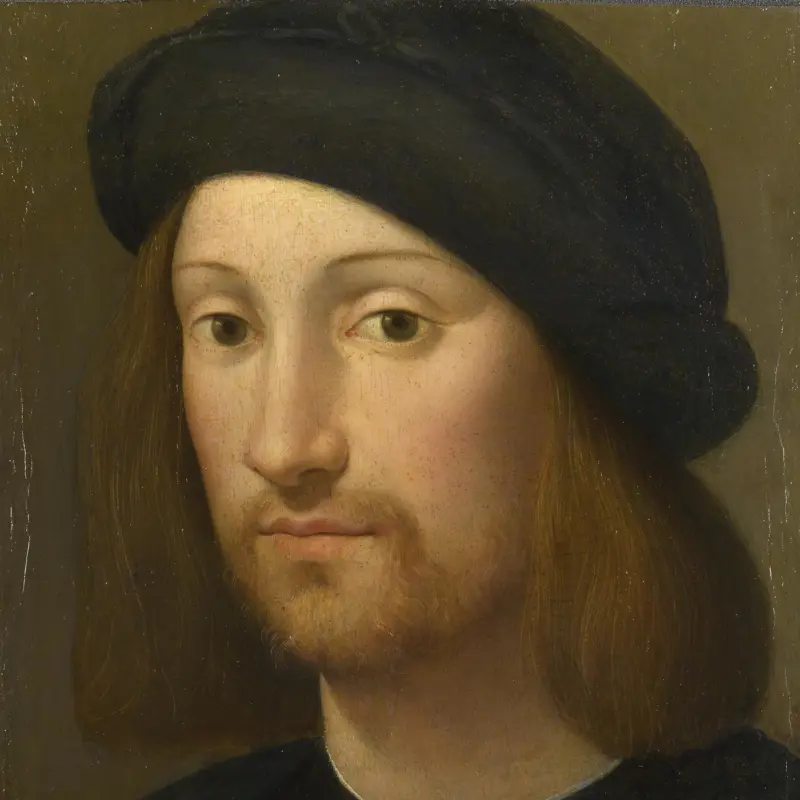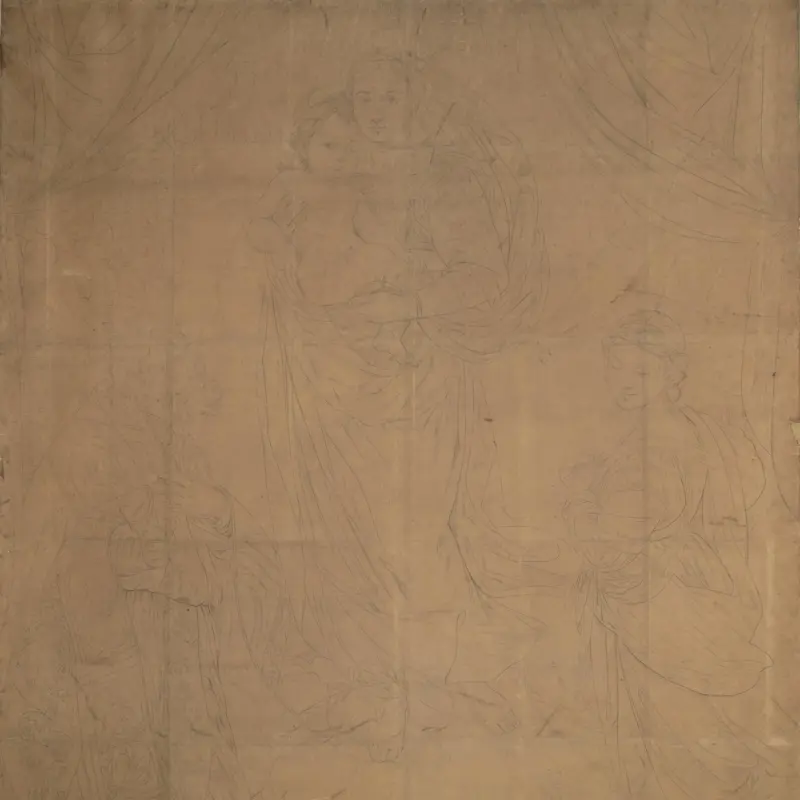Raphael, 'The Procession to Calvary', about 1504-5
About the work
Overview
This is one of three scenes from the predella of Raphael’s Colonna Altarpiece painted for the convent of S. Antonio da Padua in Perugia. The Procession to Calvary was the central scene of the predella, positioned below the main panel of the altarpiece.
Christ looks to us as he carries the Cross, helped by Simon of Cyrene and escorted by five foot soldiers. The Virgin Mary is supported by the Three Marys and accompanied by Saint John the Evangelist, who wrings his hands in grief. The three distinct groups of the procession are linked together by a rhythm of repeated colour and by the figures who look back over their shoulders at the groups behind.
Several of the figures show the influence of other artists, including Leonardo, Filippino Lippi and Justus of Ghent, demonstrating how Raphael was assimilating different approaches and ideas into his own developing style during this early period of his career.
Key facts
Details
Provenance
Additional information
Text extracted from the ‘Provenance’ section of the catalogue entry in Cecil Gould, ‘National Gallery Catalogues: The Sixteenth Century Italian Schools’, London 1987; for further information, see the full catalogue entry.
Exhibition history
-
2018Raffaello e l’eco del mitoPinacoteca dell'Accademia Carrara27 January 2018 - 6 May 2018
-
2022The Credit Suisse Exhibition: RaphaelThe National Gallery (London)9 April 2022 - 31 July 2022
Bibliography
-
1786J. Couché, Galerie du Palais-Royal gravée d'après les tableaux des différentes écoles qui la composent, avec un abrégé de la vie des peintres et une description historique de chaque tableau, Paris 1786
-
1822J. Young, A Catalogue of the Pictures at Leigh Court, Near Bristol: The Seat of Philip John Miles, Esq., with Etchings from the Whole Collection, London 1822
-
1824W. Buchanan, Memoirs of Painting: With a Chronological History of the Importation of Pictures by the Great Masters into England Since the French Revolution, London 1824
-
1854G.F. Waagen, Treasures of Art in Great Britain: Being and Account of the Chief Collections of Paintings, Drawings, Sculptures, Illuminated Mss. […], vol. 2, trans. E. Eastlake, London 1854
-
1860J.D. Passavant, Raphaël d'Urbin et son père Giovanni Santi, Paris 1860
-
1878G. Vasari, Le vite de'più eccellenti pittori, scultori ed architettori: Con nuove annotazioni e commenti di Gaetano Milanesi, ed. G. Milanesi, 8 vols, Florence 1878
-
1882J.A. Crowe and G.B. Cavalcaselle, Raphael: His Life and Works, 2 vols, London 1882
-
1897J.O. Granberg, La galerie de tableaux de la reine Christine de Suède, Stockholm 1897
-
1902J.P. Richter, 'Review: The Old Masters at Burlington House', Art Journal, 1902, pp. 81‑5
-
1910R. Fry, 'The Umbrian Exhibition at the Burlington Fine Arts Club', The Burlington Magazine, XVI/83, 1910, pp. 267-74
-
1923A. Rosenberg, Raffael, des Meisters Gemälde, in 274 Abbildungen, ed. G. Gronau, Berlin 1923
-
1923P. Schubring, 'Die Predella zu Raffaels Altar für S. Antonio in Perugia', Cicerone, XV, 1923, pp. 3-7
-
1931P. Hendy, The Isabella Stewart Gardner Museum: Catalogue of the Exhibited Paintings and Drawings, Boston 1931
-
1940H.B. Wehle, A Catalogue of Italian, Spanish and Byzantine Paintings, New York 1940
-
1948O. Fischel, Raphael, trans. B. Rackham, London 1948
-
1962Gould, Cecil, National Gallery Catalogues: The Sixteenth Century Italian Schools (excluding the Venetian), London 1962
-
1971L. Düssler, Raphael: A Critical Catalogue of His Pictures, Wall-Paintings and Tapestries, trans. S. Cruft, London 1971
-
1975C. Gould, Delaroche and Gautier: Gautier's Views on the 'Execution of Lady Jane Grey' and on other Compositions by Delaroche, London 1975
-
1977K. Oberhuber, 'The Colonna Altarpiece in the Metropolitan Museum and Problems of the Early Style of Raphael', Metropolitan Museum Journal, XII, 1977, pp. 55-91
-
1978E. Fahy, 'Italian Paintings at Fenway Court and Elsewhere', The Connoisseur, CXCVIII, 1978, pp. 28-9
-
1980P. Murray, The Dulwich Picture Gallery: A Catalogue, London 1980
-
1980F. Zeri and E.A. Gardner, A Catalogue of the Collection of the Metropolitan Museum of Art: Sienese and Central Italian Schools, New York 1980
-
1982P. de Vecchi, Tout l'oeuvre peint de Raphael, Paris 1982
-
1983J.-P. Cuzin, Raphaël: Vie et oeuvre, Fribourg 1983
-
1986S.F. Pagden, 'The Early Raphael and His Umbrian Contemporaries', Studies in the History of Art, XVII, 1986, pp. 93-107
-
1987Gould, Cecil, National Gallery Catalogues: The Sixteenth Century Italian Schools, London 1987
-
1989S.F. Pagden and M.A. Zancan, Raffaello: Catalogo completo dei dipinti, Florence 1989
-
1994E. Borsellino, 'Cristina di Svezia collezionista', Ricerche di storia dell'arte, LIV, 1994, pp. 4-16
-
1995R. White and J. Pilc, 'Analyses of Paint Media', National Gallery Technical Bulletin, XVI, 1995, pp. 85-95
-
1996J. Shearman, 'On Raphael's Chronology 1503-1508', in V. von Flemming and S. Schütze (eds), Ars naturam adiuvans. Festschrift für Matthias Winner zum 11. März 1996, Mainz am Rhein 1996, pp. 201-7
-
1999C. Wagner, Farbe und Metapher: Die Entstehung einer neuzeitlichen Bildmetaphorik in der vorrömischen Malerei Raphaels, Berlin 1999
-
2001
C. Baker and T. Henry, The National Gallery: Complete Illustrated Catalogue, London 2001
-
2001J. Meyer zur Capellen, Raphael: A Critical Catalogue of His Paintings, vol. 1, Beginnings in Umbria and Florence, ca. 1500-1508, Landshut 2001
-
2002M.W. Kwakkelstein, 'The Model's Pose: Raphael's Early Use of Antique and Italian Art', Artibus et historiae, XXIII/46, 2002, pp. 37-60
-
2002D. Bomford et al., Underdrawings in Renaissance Paintings (exh. cat. The National Gallery, 30 October 2002 - 16 February 2003), London 2002
-
2003M. Olin, 'La regina Cristina collezionista di opere d'arte', in Cristina di Svezia: Le collezioni reali, Milan 2003, pp. 47-55
-
2004A. Roy, M. Spring and C. Plazzotta, 'Raphael's Early Work in the National Gallery: Paintings before Rome', National Gallery Technical Bulletin, XXV, 2004, pp. 4-35
-
2004H. Chapman, T. Henry and C. Plazzotta, Raphael: From Urbino to Rome (exh. cat. The National Gallery, 20 October 2004 - 16 January 2005), London 2004
-
2006L. Wolk-Simon, 'Raphael at the Metropolitan: The Colonna Altarpiece', Metropolitan Museum of Art Bulletin, LXIII, 2006, pp. 4-75
-
2006L. Wolk-Simon, Raphael at the Metropolitan: The Colonna Altarpiece (exh. cat. Metropolitan Museum of Art, 2006), New York 2006
-
2007M. Spring, 'Raphael's Materials: Some New Discoveries and their Context within Early Sixteenth-Century Painting', in A. Roy and M. Spring (eds), Raphael's Painting Technique: Working Practices before Rome: Proceedings of the Eu-ARTECH Workshop, Florence 2007, pp. 77-86
-
2022Plazzotta, Carol, and Tom Henry, National Gallery Catalogues: The Sixteenth Century Italian Paintings, 4, Raphael, London 2022
Frame
This is a nineteenth-century Italian replica frame. It has a reverse pinewood moulding with gilt back edge. The blue and gold frieze is adorned with scrolls and leaves, made using the sgraffito technique.
In 1995 a new reverse moulding was fitted to follow the curvature of Raphael’s The Procession to Calvary, reducing the shadows cast on the picture for optimal presentation.
Photographs of the National Gallery’s ‘Raphael room’ from 1923 show The Procession to Calvary in a decorative frame with entablature and pastiglia ornamentation.
About this record
If you know more about this work or have spotted an error, please contact us. Please note that exhibition histories are listed from 2009 onwards. Bibliographies may not be complete; more comprehensive information is available in the National Gallery Library.

